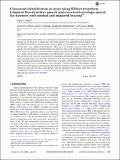| dc.contributor.author | Reed, Charlotte M. | |
| dc.contributor.author | Desloge, Joseph G. | |
| dc.contributor.author | Swaminathan, Jayaganesh | |
| dc.contributor.author | Braida, Louis D. | |
| dc.contributor.author | Leger, Agnes C. | |
| dc.date.accessioned | 2015-11-10T19:40:27Z | |
| dc.date.available | 2015-11-10T19:40:27Z | |
| dc.date.issued | 2015-07 | |
| dc.date.submitted | 2015-04 | |
| dc.identifier.issn | 0001-4966 | |
| dc.identifier.uri | http://hdl.handle.net/1721.1/99898 | |
| dc.description.abstract | Consonant-identification ability was examined in normal-hearing (NH) and hearing-impaired (HI) listeners in the presence of steady-state and 10-Hz square-wave interrupted speech-shaped noise. The Hilbert transform was used to process speech stimuli (16 consonants in a-C-a syllables) to present envelope cues, temporal fine-structure (TFS) cues, or envelope cues recovered from TFS speech. The performance of the HI listeners was inferior to that of the NH listeners both in terms of lower levels of performance in the baseline condition and in the need for higher signal-to-noise ratio to yield a given level of performance. For NH listeners, scores were higher in interrupted noise than in steady-state noise for all speech types (indicating substantial masking release). For HI listeners, masking release was typically observed for TFS and recovered-envelope speech but not for unprocessed and envelope speech. For both groups of listeners, TFS and recovered-envelope speech yielded similar levels of performance and consonant confusion patterns. The masking release observed for TFS and recovered-envelope speech may be related to level effects associated with the manner in which the TFS processing interacts with the interrupted noise signal, rather than to the contributions of TFS cues per se. | en_US |
| dc.description.sponsorship | National Institute on Deafness and Other Communication Disorders (U.S.) (Award R01DC000117) | en_US |
| dc.language.iso | en_US | |
| dc.publisher | Acoustical Society of America (ASA) | en_US |
| dc.relation.isversionof | http://dx.doi.org/10.1121/1.4922949 | en_US |
| dc.rights | Article is made available in accordance with the publisher's policy and may be subject to US copyright law. Please refer to the publisher's site for terms of use. | en_US |
| dc.source | Acoustical Society of America | en_US |
| dc.title | Consonant identification in noise using Hilbert-transform temporal fine-structure speech and recovered-envelope speech for listeners with normal and impaired hearing | en_US |
| dc.type | Article | en_US |
| dc.identifier.citation | Léger, Agnès C., Charlotte M. Reed, Joseph G. Desloge, Jayaganesh Swaminathan, and Louis D. Braida. “Consonant Identification in Noise Using Hilbert-Transform Temporal Fine-Structure Speech and Recovered-Envelope Speech for Listeners with Normal and Impaired Hearing.” J. Acoust. Soc. Am. 138, no. 1 (July 2015): 389–403. © 2015 Acoustical Society of America | en_US |
| dc.contributor.department | Massachusetts Institute of Technology. Department of Electrical Engineering and Computer Science | en_US |
| dc.contributor.department | Massachusetts Institute of Technology. Research Laboratory of Electronics | en_US |
| dc.contributor.mitauthor | Reed, Charlotte M. | en_US |
| dc.contributor.mitauthor | Desloge, Joseph G. | en_US |
| dc.contributor.mitauthor | Swaminathan, Jayaganesh | en_US |
| dc.contributor.mitauthor | Braida, Louis D. | en_US |
| dc.relation.journal | The Journal of the Acoustical Society of America | en_US |
| dc.eprint.version | Final published version | en_US |
| dc.type.uri | http://purl.org/eprint/type/JournalArticle | en_US |
| eprint.status | http://purl.org/eprint/status/PeerReviewed | en_US |
| dspace.orderedauthors | Léger, Agnès C.; Reed, Charlotte M.; Desloge, Joseph G.; Swaminathan, Jayaganesh; Braida, Louis D. | en_US |
| dc.identifier.orcid | https://orcid.org/0000-0003-1680-1913 | |
| dc.identifier.orcid | https://orcid.org/0000-0002-8431-4730 | |
| dc.identifier.orcid | https://orcid.org/0000-0003-2538-9991 | |
| mit.license | PUBLISHER_POLICY | en_US |
| mit.metadata.status | Complete | |
